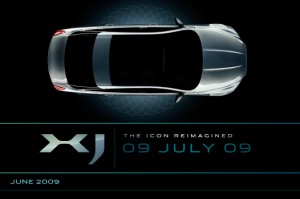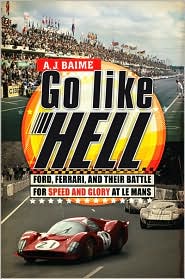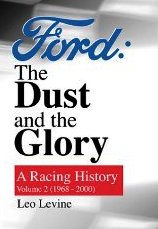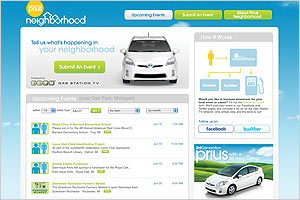Our Federal Automobile Websites
Illegal sites are up and running in an attempt to con and deceive gullible consumers about the Cash for Clunkers program, now known officially as the Car Allowance Rebate System — CARS, isn’t that cute? NHTSA has set up an official web site to provide information about the program. The agency also has a hotline at 888-327-4236. Consumers can visit that Web site or call the hot-line number to get official information about the program.
For MPG data, the government’s fuel economy website is a very good. There are charts to show fuel consumption for hundreds of makes and models going back to 1985. Other interesting information includes links to many non-government auto websites.
Jaguar’s 30 Day Countdown to a New Car
There was a time when new car dealers would white-out their showroom windows with just few peep-holes to look through to see their newest car. Slowly the viewing area got bigger so more of the car was seen. When I was a kid, one of the high spots of the year was going downtown to take a peak-look at the new cars on a dealer’s showroom floors.
That “tease strategy” isn’t used anymore, but Jaguar has adapted it for today’s digital, Internet world of commerce and information with a 30 day teaser series of videos using Jag execs emailed to those who have registered at the site. Jag’s teaser began with an ad and p.r. campaign directing the reader to a special website where videos are running until July 3 on features of the new XJ. Print ads will run till the international reveal on July 9th in London.
Go Like Hell Details Ford versus Ferrari
The 77th Le Mans race, which ran a couple of weeks ago, received little media attention here in America. But in the mid 1960s, and the 1965 Le Mans race in particular, the battle between Ford and Ferrari to win the grueling event was major news in every medium.
It’s all been intriguingly covered in A. J. Baime’s just published book Go Like Hell: Ford, Ferrari, and Their Battle for Speed and Glory at Le Mans.
Baime, a Playboy magazine executive editor, devoted four years to researching, interviewing and writing this captivating, intriguing, can’t-stop-turning-pages read. All while doing his daily job at Playboy. When I asked him how, Baime said, “I didn’t sleep for three years.”
For those who don’t remember, young Henry Ford II, who had taken charge of his grandfather’s company in the late 1950s, began a unique quest to establish Ford as the premiere American car company in Europe by beating Ferrari at Le Mans, where it was a consistent winner. win by Ford, he knew, would help make Ford the dominant global auto brand.
This is more than a jock book for gear heads and racing fans even though it is focused on the 24 hour Le Mans race. Sure it’s a racing story about a historic business war, but it’s more, much more.
Go Like Hell is about business icons Henry Ford II and Enzio Ferrari and their divergent personalities, of skilled and fearless racecar drivers, of money — lots and lots of money — cultural differences, conflicts between people, companies and societal attitudes of the sixties, the golden years of American’s love of the automobile.
When I asked him about writing the book, Baime commented, “Many people who do not like horse racing read Sea Biscuit (and saw the movie) because it told an amazing story. I’ve tried to capture that context in Go Like Hell and tell an amazing story to those who like auto racing and those who don’t.”
Baime had access to and interviewed many of the individuals still alive or those who knew them well; his research into newspaper, magazine and television archives both in the U.S. and Europe was extensive. Result? He has recreated scenes, settings and situations filled with amazing personalities with fascinating detail. He brings it all to life.
The lead character is Henry Ford II, known in auto circles as The Deuce, was the inexperienced business grandson of Henry Ford I, who as a 28-year-old became president and CEO of Ford Motor Company, then the world’s second largest company.
But the young man became an aggressive competitor with a keen eye for talent. After WWII, he hired a cadre of future business, political and government leaders called the Whiz Kids to organize Ford Motor Company.
Ferrari, the former Alfa race driver was an enigmatic, driven, even troubled man, who built his successful company from the remnants of his factory, turned to rubble following WWII bombing, with focus, determination and very fast and expensive automobiles.
The back-story evolves from early NASCAR auto racing in the U.S. (remember the phrase: What wins on Sunday, Sells on Monday?) and Ford’s battle with Chevrolet. But The Deuce wanted a worldwide company and knew winning the Le Mans race would quickly build the Ford brand in Europe, so he sought to buy Ferrari.
But then at the contract signing which would have sealed the deal, Enzio Ferrari, in a Machiavellian moment, refused to sign a multi-million dollar contract because of potential conflict that was really non-existent…
And thus the war of auto magnets and auto companies began.
Ford marshaled his forces. He promoted a young Lee Iacocca, a true marketing genius to run the Ford business and then hired Carol Shelby to command the war with Enzio Ferrari and their famous winning Ferrari racecars along with many engineers, designers and drivers.
Baime tells the captivating back-stories and anecdotes and provides insider detail of the fame, fate and foibles of Ford and Ferrari. It’s all here including the peccadilloes, some poignant and provocative moments.
It’s augmented with profiles of their business colleagues and the fearless men who drove their racecars and helped each achieve glory often through deaths in terrible accidents and crashes.
Today’s disastrous automotive business world is repeating some of the industry’s historical mistakes while simultaneously creating new problems. Who and where are the leaders to shape tomorrow’s car business? Baime’s book will make you think and ponder … which is good, isn’t it?
If you didn’t get a copy for Father’s Day, buy one for yourself, don’t wait for the movie. You won’t be disappointed. For an excerpt from Go Like Hell and Le Mans historical photos, videos and more go to the site.
(Editor’s Note: While marketing people are biased toward the new, and understandably love to talk about such, if you are seriously interested in Ford racing, and want to get a shameless bargain in the process, consider Ford: The Dust and The Glory.
This out of print racing history in two volumes by Leo Levine is available from Amazon.com for a pittance. It is a must read and a definitive reference work about all of Ford’s racing history.
Volume 1 contains extensive coverage of the LeMans racing effort written by a professional sportswriter and automotive p.r. guru when many more of the actual participants were alive. — Ken Zino)
It Should be a Golden Geezer Marketing World
According to a recent McKinsey Consulting study, by 2010 50% of all consumer spending in America will be by people over the age of 50. That’s a golden opportunity, right? How ’bout them Golden Geezers?
But who knows how to tell the story to our aging population? Advertising agency creative personnel are young, very young, an average age of 28, the sturdy reports. What’s more, fewer than 5% of all agency personnel are over 50. And thinking about marketing personnel at their client automobile companies I have seen, there are fewer older (think seasoned) people than in the past, which in part has been caused by various economic woes.
The result is problematic. The focus of most brands is the 18-34 age group. A group, Brent Bouchez, a founder of Agency Five0, a company dedicated to messaging and content for aging boomers noted in Media Post’s Engaging Boomers, “receives 90% of today’s marketing dollars.”
But that was true, Bouchez feels in 1975 when the 18 to 34 group was in the middle of the baby boom.
The boy who never wanted to grow up would feel at home in just about any of today’s advertising agencies, right alongside other young, bright, talented people whose job it is to create messages for a world of consumers who look, act and feel just like they do.
In advertising parlance, it’s called targeting the “sweet spot.”
The sweet spot is people aged 18 to 34. Ninety percent of today’s marketing dollars are spent trying to reach this group. Marketers lust after them, and media companies do everything in their power to lure them to their websites, magazines, and TV channels.
This makes perfect sense. Or at least it did in 1975.
Because in 1975, people 18 to 34 were smack in the middle of the baby boom, “The largest group of consumers in history with the most money to spend in history. In the ’70’s and ’80’s and even some of the ’90’s, boomers could make or break a brand.
They could also make or break an advertising agency.”
But today the Baby Boomers average age is 53, and not in the sights of most marketers or their agencies. A few facts the article detailed are very interesting, and based on my research, are very accurate:
- People 50+ earn $2.4 trillion annually, compared to $1 trillion for the 18-34 group.
- According to McKinsey, people 50+ generate 41% of all disposable income.
- They buy 60% of all packaged goods, over half of all new cars and spend 75% more per vacation than consumers under 50.
- In 2007, people over 50 spent 3.5 times the national average holiday shopping online.
And yet, nationwide research by AARP shows that the majority of consumers over 50 feels that advertising and marketing either portrays them negatively or ignores them altogether. Why? Because it’s being created by people at least 20 years younger.
Bouchez wrote, “Boomers have become smart, savvy, worldly, respected and ready for the next chapter of their lives. And they want to be marketed to in a way that understands and respects not who they were, but who they are. In today’s economy, they are the people with the money who can buy your product.”
If you’re in this demographic group, wasn’t the last piece of targeted direct mail you received from AARP or an investment advisor, but from a marketer, much less an automobile brand? Hmmmmm.
Fill It Up at the Pump and Watch A Prius TV Commercial
According to a recent report, Gas Station TV and Toyota are launching a new “community-generated” TV program, “Prius Neighborhood,” devoted to local events and activism. It will allow consumers to inform and organize each other about various causes, while highlighting the brand’s theme of environmental responsibility and sustainability.
The just-launched localized program invites viewers to submit event details by visiting a special microsite within the Gas Station TV Web site. GSTV reviews and integrates them into its rotating listing of events and organizations. The listings are also searchable on the Web site by Zip code. The events are also posted to regional Twitter pages under “@GSTVevents” and on Facebook, allowing visitors to become fans of “Prius Neighborhood,” interact with each other and post events through a special Facebook application developed for Toyota.





